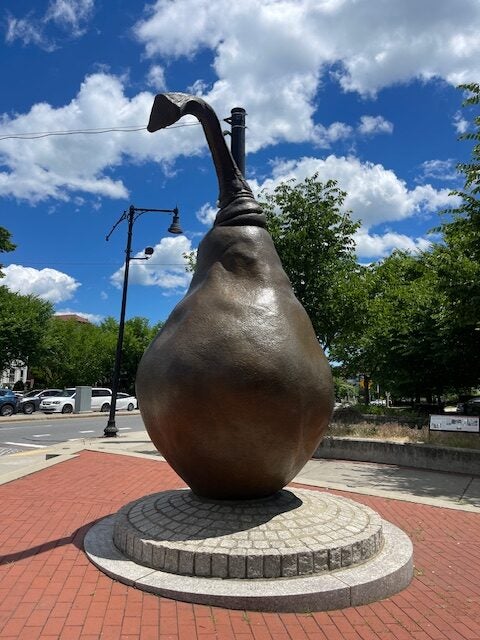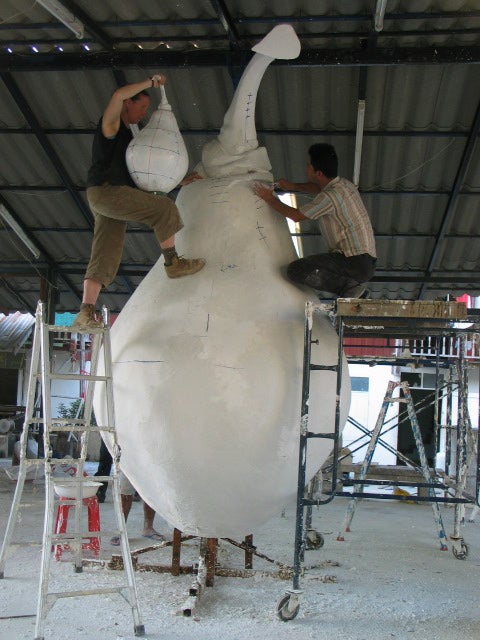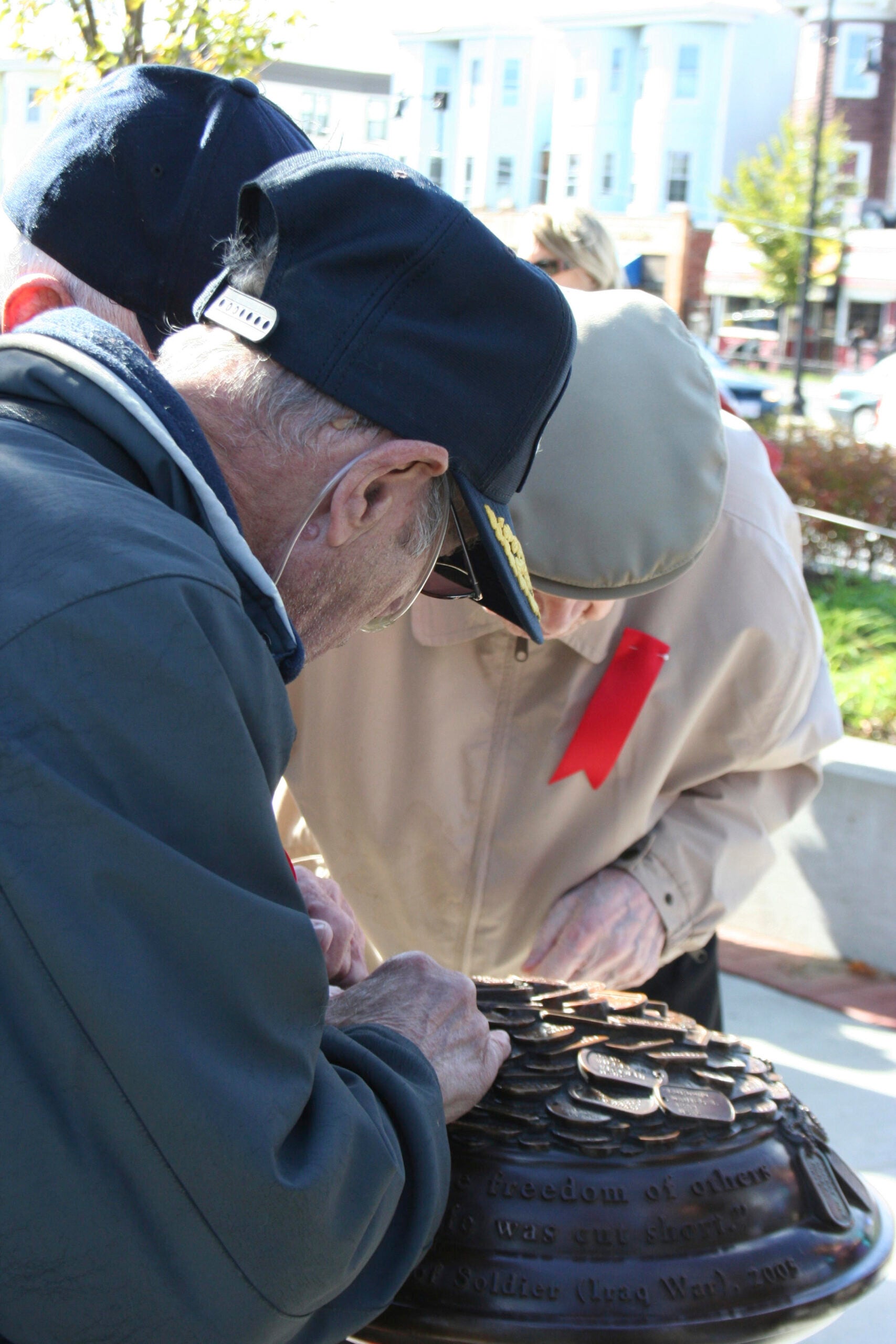Wickedpedia
“It’s a monument to the people of Dorchester, and it’s a monument to [their] experiences.”

A 12-foot-tall, bronze statue of a pear sitting just off a busy Boston intersection may seem out of place.
“I cannot even make something up. Why would a pear be here?” said Dorchester resident Jaahnavi Bodkhe, who passes by the statue often.
But the strange, looming metal fruit actually has a lot to do with Boston’s largest and most diverse neighborhood. The sculpture is a tribute to the history of Dorchester and the hardworking nature of the neighborhood’s residents.
“Dorchester has a special meaning to me,” said Brent Doucette, a Dorchester resident whose father grew up in the neighborhood. “[The pear] represents the fruit of your labor — Dorchester is a working class community.”
The statue is not just a random pear. It’s modeled after Clapp’s Favorite Pear, a variety of the fruit first cultivated in Dorchester.
Surrounding it are 10 more pieces of intricate, smaller art that all relate to Dorchester’s history.
“It’s a monument to the people of Dorchester, and it’s a monument to [their] experiences,” said Laura Baring-Gould, the artist behind the statue. “It’s a public artwork that desires for the work to be truly public, so people will see themselves in it and realize that connection. Their story is very unique and utterly important to them, but there’s a connection to someone else — past, present, or future.”
The statue honors Dorchester’s rich agricultural history
The Clapp Pear was first grown in Dorchester in the 1800s.
The pear stands in Edward Everett Square at the intersection of Columbia Road and Massachusetts Avenue. The area was once the site of fields, pastures, and orchards during Dorchester’s agricultural past.
Before its annexation into Boston in 1870, Dorchester was a fertile agricultural ground for many fruits and vegetables, including cherries, blackberries, and strawberries.
“Dorchester was one of those neighborhoods that supplied Boston with food [and] just happened to have a great many pear growers,” said Earl Taylor, president of the Dorchester Historical Society.
The Clapp family name has deep ties to the neighborhood. Roger Clapp was one of the first English colonists in the region, settling in what is now Dorchester in 1630.
His descendants, namely William Clapp and his sons, bred a hybrid of the Bartlett and Flemish Beauty pears, creating “Clapp’s Favorite Pear.”
Edward Everett Square — itself named after statesman Edward Everett, who was born on an estate where the square is now — became a major intersection in Boston, with little space for community.
In 1995, a group of residents, led by John McColgan, treasurer of The Pear Square Collaborative and a longtime Dorchester resident, set out to beautify the square and provide a green space for the neighborhood.
“John McColgan was the prime mover, and for years [the Edward Everett Square Committee] was trying to lessen the asphalt in the square and reduce some of the traffic in certain areas,” said Taylor, who was also part of the committee.
In 2005, they selected Baring-Gould to exhibit her work in the square.
“It was really important to me to bring material of value into Dorchester. Dorchester deserves beautiful artwork,” Baring-Gould said.
The artist said she was inspired to replicate a Clapp Pear because of its characteristically tough, thick exterior but soft and sweet inside — a metaphor for the hardworking residents of Dorchester, who she said will “give you the shirt off their back.”
The sculptor also wanted each piece in the exhibit to be physically accessible to visitors.

“It was very important that these pieces be tangible, that they be direct, and that people see themselves in it,” Baring-Gould said, adding that she noticed a lot of existing art in the neighborhood was placed high and out of people’s reach. “If we’re going to do this, we have to bring something of value, because this is people’s home and we’re trying to have them celebrate this community. So I knew that what I wanted was something that people could touch and people could interact with.”
The giant pear is as accurate to an actual Clapp Pear as can be. Baring-Gould traveled to Washington, where Clapp Pears are now grown, to get an average sized, three-inch pear to base her work off of. She then upscaled it to two feet tall and then, finally, to its full 12-foot stature.
Two years later, after being molded in Thailand, the pear was placed where it stands today.
“I’ll never forget the sights and the feeling of seeing the pear in a big truck being hauled into the square and being put in place,” McColgan said.

The pear is only one piece of the museum-like exhibit now gracing the square. In 2010, 10 smaller sculptures were unveiled near the pear, all showcasing some aspect of Dorchester’s history.
“I knew the gem of the work would be in the smaller pieces, because these are the pieces that celebrate people’s individual history while tying the threads together to speak about common history,” Baring-Gould said.
Among the smaller pieces are dog tags, a rotary phone, and a pair of shoes, all molded using real objects collected from community members.
The shoes, Baring-Gould said, were molded using her own studio shoes. They represent the immigrants that arrived in Dorchester with “nothing but endurance and community,” the artist said.

The dog tags were collected and sculpted from real tags of Dorchester veterans. Intricate corn and squash replicas celebrate the Indigenous people who lived on the land.
On each bollard where smaller art pieces stand are inscribed quotes from community members, collected by Baring-Gould through extensive research and oral histories, she said.
“Dorchester voices are not about voices you find in high places,” the artist said. “They’re about the people in the community who have done so much because they care about the community.”
One quote was given by the mother of a Dorchester veteran who died in Iraq while Baring-Gould was working on the sculpture, she said. Her quote reads, “For the sake of others, his life was cut short.”
“If you’re making public artwork and it’s going into a place where people live, it’s really important to honor the lives and experiences of the people who lived there,” Baring-Gould added. “I wanted to come up with a concept that wouldn’t celebrate just one person’s history.”
By the end of the project, the main funds used to create the pear had run out. That’s when individual community members came into play.

A resident volunteered the crane used to install the pear, according to Baring-Gould and McColgan. And when there was no money to install the art exhibit on top of bricks, residents bought their own bricks and added personal quotes to them.
Some bricks commemorate important Dorchester authors, while others display the names of labor unions, another integral part of the neighborhood’s identity.
McColgan and the artist are currently trying to revitalize and clean up the square, with a GoFundMe set up to help with funds.
Through true community collaboration, Edward Everett Square has become a cherished centerpiece of the neighborhood

“I see the pear as a metaphor of sustenance for so many people, coming from so many places over so many years, for so many centuries,” McColgan said. “But since we’re all in the same place, we also have a history of Dorchester itself. Awareness of local history can help build a shared culture and trust among [the community].”
“All of [the sculptures] relate to some theme that might make a passerby start to question, ‘What do I know? What should I know about?’” Taylor said.
And the pear itself has become an icon of Dorchester, McColgan added, being a recognizable landmark in art and photographs of the neighborhood.
Even for Bodkhe, who didn’t know why the pear was there, the sculpture is a jewel of the community.
“This neighborhood has a lot of hidden gems, and this is one of them,” she said.
Newsletter Signup
Stay up to date on all the latest news from Boston.com








Leave a Comment